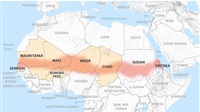Muslim Brotherhood maintaining conspiracies against US

The Muslim Brotherhood started taking root in the United States soon after it was founded in Egypt.
The Islamic Society of North America, known to be a branch
of the Muslim Brotherhood in the United States, was founded in the first half
of the 1960s.
The society is an important tool for this Islamic
organization in gaining influence in the United States. It functions as a link
between the International Organization of the Muslim Brotherhood, on one hand,
and the American administration, on the other.
The Muslim Youth League was founded in 1963 after the
arrival of hundreds of Muslim youth to the United States for study in its
different universities.
The league turned into the Islamic Society of North America
in 1981. Several Islamic countries financed the society then. The society also
enjoyed support from top figures of the International Organization of the
Muslim Brotherhood, including Sheikh Youssef al-Qaradawi and former Qatari emir
Hamad bin Khalifa al-Thani.
The society controls between 50% and 80% of mosques in the
United States and Canada. This control gives the Muslim Brotherhood strong
access to American streets.
In 1991, a Muslim Brotherhood document showed that the
Islamist organization's objective in the United States was to turn it into a
Muslim nation.
The first generation of Muslim Brotherhood members in the
United States consisted of those who belonged to the organization in their home
countries and religious Muslims.
According to Zayed al-No'man, a Brotherhood leader in the
United States, the presence of these people formed the nucleus of Muslim
Brotherhood influence in the United States.
He added in an interview in the early 1980s that those
forming the core of the Muslim Brotherhood in America were mere Brotherhood
enthusiasts.
These people succeeded in sowing the Muslim Brotherhood
seed in America, he said.
An organizational group, he said, was formed later with the
aim of coordinating the work of all Muslim Brotherhood groups around the world.
These different Muslim Brotherhood groups produced their own
leaders who formed their own senior leadership body.
Some of the Brotherhood leaders then suggested giving their
group the name "Cultural Group."
The group aimed at protecting the cultural identity of
Muslims. However, the group was a mere façade for Muslim Brotherhood members to
protect them against arrest.







